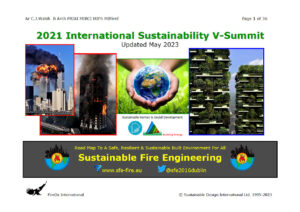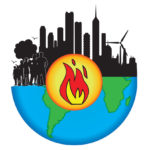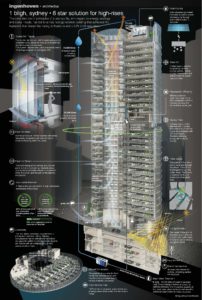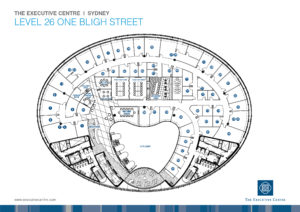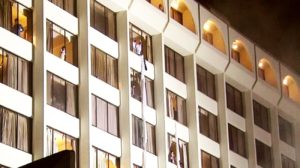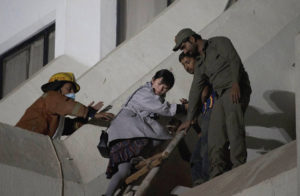2011-07-15: The recent failure by European Union Environment Ministers to increase, unconditionally, the EU 2020 GHG Emission Reduction Target from 20% below 1990 levels to 30% … and the even more recent vote in the European Parliament against such an unconditional increase … leaves a stench in the nostrils. Something stinks … and it’s the EU’s Climate Change Policy. Too many alterations to the European Lifestyle … too many sacrifices … are required to effectively implement a ‘real’ climate change policy !
Taken as a whole … this is also a reliable indicator with regard to what is not happening in a strongly related policy area … the implementation of EU Sustainability Policy.
.
The next BIG United Nations International Climate Change Conference in 2011 – COP 17 – will take place from 28 November to 9 December, 2011 … in Durban, South Africa. Let’s not get our hopes up for the long-awaited, very necessary and urgent Global, Legally Binding Consensus Agreement on Climate Change Mitigation to be finalized there … but let’s not be too negative either !
And how are the UNFCCC Annex I Countries doing so far ? For an answer, please follow the link below to the United Nations Framework Convention on Climate Change (UNFCCC) WebSite …
Official UNFCCC Map – All Annex I Countries
I wrote ‘an answer’ … as this is not ‘the answer’ … because the Climate Change Numbers produced by each country are not yet sufficiently accurate, precise and reliable. In fact, there is so much massaging of numbers that it might be better just to imagine this whole process as the Climate Change Red Light District !
BUT … we do know enough to be able to identify the worst offenders:
- 34 – IRELAND !
- 35 – Iceland
- 36 – Greece
- 37 – Portugal
- 38 – New Zealand
- 39 – Spain
- 40 – Canada
- 41 – Australia
- 42 – Malta
- 43 – Turkey
.
Looking back to when the Climate Change ‘Train’ began to come off the rails … the 2009 Copenhagen Accord was a political agreement between a small number of Heads of State, Heads of Government, Ministers, and Heads of Delegation from Brazil, South Africa, India and China (BASIC) and the USA … who attended the UNFCCC Climate Change Summit in December 2009. Many countries have made voluntary submissions, i.e. not legally binding, to Appendices I and II of the Accord.
A general overview of the submissions made by the Developed Economies, however, reveals the following about the emissions targets being undertaken …
– they are highly conditional on the performance of other countries ;
– they are very disappointing … being far below what is required to cap the planetary temperature rise at 1.5 degrees Celsius ; and
– there is no consistent emission base year … varying, for example, from 1990, 1992, 2000 to 2005.
This is very far from being a signal of serious intent from these countries … and is not … in any way, shape or manner … an acceptance of historical responsibilities. It would be reasonable, therefore, to surmise that the process of achieving a global, legally binding, consensus agreement on greenhouse gas (GHG) emission reduction targets will be long and difficult. The Climate Change Mitigation Agenda is fraught with difficulty … and is going absolutely nowhere at present !
Some Conclusions about Copenhagen and Since:
- The Danish Organizers were entirely responsible for the 2009 Climate Change Train Wreck ! And … this incompetent bungling continues to contaminate events since then.
- All Sectors of Europe’s Social Environment must now take seriously, i.e. pro-actively engage with, the Climate Change Adaptation Agenda … and prepare for a planetary temperature rise of at least 3-4 degrees Celsius before the end of this century !!
.
Meanwhile, at national level in Ireland … and further to my post, dated 23 February 2011 … the Environmental Protection Agency (EPA) issued the following Press Release on 4 July 2011 …
‘ Kerdiffstown Landfill Remediation Project – Community Update Number No. 4
Gas flares at the Kerdiffstown Landfill are now installed and fully operational. The flares burn off odorous gas that is collected by gas wells in two areas at the site – the lined landfill cell, and the North-West corner.
The lined landfill cell has now been fully covered with a heavy plastic membrane that will prevent gas escaping into the air. This membrane will also stop rainwater getting into the waste and creating ‘leachate’ – the residual liquid that seeps through waste after rainfall.
These temporary gas control measures should result in a reduction in odour coming from the site. Odour will continue to be encountered on occasion until the full remediation is completed and, in particular, there is a risk of odour during work phases where wastes will be disturbed.
The next major remedial works to occur on site will be the demolition of a number of unsafe buildings. The buildings are scheduled to be demolished in August, and the EPA will communicate the specific dates before the works commence.
On Friday, 1 July 2011, the EPA welcomed a number of TDs, councillors, council officials and members of the local community to the site for a briefing, and tour of the site works done to date. The EPA would like to thank deputies Emmet Stagg, Anthony Lawlor, and Catherine Murphy, and Councillors Anne Breen, Emer McDaid, and Ger Dunne, for attending.
The EPA then met with members of the Local Community for the first Community Liaison Group meeting. This group was formed to ensure that those people affected by the site can communicate directly with the people who will clean the site. The Liaison Group includes EPA staff, Kildare County Council officials, members of CAN (Clean Air Naas), a representative from Kerdiffstown House, and local residents and business people. The group took a tour of the site to review ongoing remedial works.
The EPA will continue to issue Community Updates as remedial works on the site take place. For information about works at the site, go to … www.kerdiffstowncleanup.ie .’
.
Please read, again, that first paragraph of the Press Release above … and pinch yourself !
Ireland’s EPA has an onerous legal responsibility with regard to the development and implementation of this country’s National Climate Change Policy. Furthermore … the EPA, on its own WebSite ( http://www.epa.ie/ ) states the following …
‘ The Environmental Protection Agency (EPA) aims to be a leader in the climate change debate in Ireland, and to be the first port of call for information on climate change. We hope that the information we provide on these WebPages will keep you informed on the latest news, research and events in the climate change area, not only in Ireland but internationally.’
.
I ask: “Why are those Landfill Gases at Kerdiffstown being burned off ???”
Because Ireland’s National Climate Change Policy is a ‘paper’ policy … an ‘Alice in Wonderland’ policy … a policy not intended for ‘real’ implementation. Surely we have a right to expect that, within the same national organization … somebody, somewhere … is able to think laterally ?
Climate Change Time is running out … and there is an immediate and desperate need for simple, direct and honest talk, consultation, awareness raising, training and education … across all sectors of our Social Environment !
.
At European level … an example, to follow below, of the continuing weak and feeble Climate Change Language still being used by EU Institutions and Official Organizations … where individual employees, of all ranks, are more fearful of offending national and/or EU politicians than they are in doing their jobs properly and protecting EU Citizens and the Environment …
A recently published European Environment Agency (EEA) Technical Report 7: ‘Safe Water & Healthy Water Services in a Changing Environment’ … summarises existing knowledge of Climate Change Impacts on water services and health; the nature and effectiveness of the policy responses; and the coverage and gaps in existing assessments of these themes.
To download the Full Technical Report, go to the EEA’s WebSite … http://www.eea.europa.eu/ .
.
‘ Climate Change, Water & Health
• Millennium Development Goal 7 (MDG7) is to halve the proportion of the global population without sustainable access to safe drinking water and basic sanitation by 2015. A World Health Organization (WHO) assessment in 2010 finds that access to improved water sources, sanitation and wastewater treatment has increased over the past two decades. In many countries in the Eastern European Region, however, progress is slow. More than 50% of the rural population in ten countries have no access to improved water, giving rise to important health inequalities.
• It is important to understand how Climate Change and Extreme Weather Events will affect the achievement of MDG7. Drinking water supplies and sanitation systems will have to be made resilient to Climate Change, and drinking water and sanitation must be fully incorporated into integrated water resource management.
• Climate Change is projected to cause major changes in yearly and seasonal precipitation and water flow, flooding and coastal erosion risks, water quality, and the distribution of species and ecosystems.
• Climate Change will impact all areas of water services – the quality and availability of water sources, infrastructure, and the type of treatment needed to meet quality standards. We will also see more frequent and severe droughts, flooding and weather events.
• Countries of Eastern Europe, the Caucasus and Central Asia face the greatest threats to safe water. The infrastructure in many towns and rural areas is in poor condition, and water provision is erratic and of unsatisfactory quality.
• Heavy rainfall events may also lead to flooding, especially in urban areas, and this can have serious impacts on the performance and efficiency of water supply and wastewater treatment systems, which may potentially lead to health risks. Waterborne diseases arise predominantly from contamination of water supplies after heavy rainfall and flooding.
• Low river flows and increased temperatures during droughts reduce dilution of wastewater effluent, and drinking water quality could be compromised, increasing the need for extra treatment of both effluent and water supplies.
Water Management Policies & Extreme Weather Events
• Water management policies at European and EU Levels are being made increasingly adaptable to Climate Change, which should help safeguard public health and ecosystem services in the future.
• There are numerous guidelines for the design of water and human health policies across Europe (e.g. WHO Guidelines on drinking water quality, Protocol on Water and Health, and draft guidance on water supply and sanitation in extreme weather). Recently, such Guidance has focused on how policy design and implementation might be affected by and adapted to Climate Change Events.
• The WHO Vision 2030 Study assesses how and where Climate Change will affect drinking water and sanitation in the medium term, and what can be done to maximise the resilience of drinking water and sanitation systems.
• Several existing EU Policies address water management issues (the Urban Wastewater Treatment Directive, the Water Framework Directive, Floods Directive and the EU Water Scarcity and Droughts Strategy) and others deal more directly with potential water-related impacts on human health (e.g. the Drinking Water Directive, and Bathing Water Directive).
• There is a clear recognition that Climate Change creates a need for coherent, sustainable, cross-sectoral policy and regulation; sharing of available tools; facilitating mechanisms for partnerships and financing; and readiness to optimise across sectors during implementation.
• The water utility sector faces a unique set of challenges. A primary challenge will be enhancing its capacity to cope with Climate Change Impacts and Other Human Pressures on water systems, while fostering greater resiliency to extreme hydrological events.
• With more frequent higher-intensity storms projected, utilities face the need to update infrastructure design practices. This necessitates investments – not necessarily only in larger structures but also smarter (using better process control technologies) or local measures on storm water run-off.
Assessment Knowledge Base
• At international, national and local levels … much information is produced for assessments of the state of water and related health impacts. Overall, both the current international and national water and health assessments have limited focus on extreme weather events and their effects on water services.
• In national assessments and programmes, countries appear to be aware of the adverse consequences of Climate Change on water and health. However, sometimes assessments appear to be based on ‘expert knowledge’, largely qualitative in scope, and not going further than identifying likely scenarios. The evidence‑base is lacking to make reliable estimates of the health effects of Climate Change resulting from impacts on water resources.
• Much effort is now focused on the impact of Climate Change on water and the environment, including health-related impacts. Many international and European organisations have mapped out future Climate Change Impacts on water-related issues, identifying vulnerable groups and vulnerable sub-regions.
• The vast majority of the assessments of drought and water scarcity have focused on the impact of water scarcity, water use by sectors and strategies for meeting demand. Very little consideration has been given to the health effects or consequences of future extreme weather events.
• The health effects of flooding do not feature significantly in national assessments. The main focus is identifying regions most at risk of flooding and preparing plans for responding and mitigating the main consequences.
• Sufficient public health competences exist to cope with the health effects of Climate Change. However, no (comprehensive) assessment has been undertaken to predict the severity or extent of future health risks related to the impact of Climate Change on water services.
• Irrespective of an assessment of the disease burden, actions being taken on the wider scale to respond to water scarcity, drought and flooding will help to reduce the health effects associated with Climate Change and water.’
.
If you were a Key Decision-Maker … would this language spur you into action … or make you yawn, and put you to sleep ???
.
.
END
